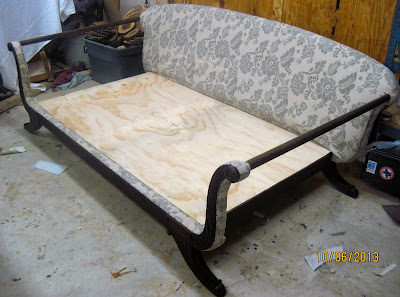I have already told you about how much I love the ease and look of the Annie Sloan Chalk Paint I have used, but now I will tell you of my attempt to make my own. I am a somewhat frugal person and paying 3X as much for a quart of chalk paint went against this frugal fiber. I had seen some homemade chalk paint recipes on some very good blogs, so I decided to try the best reviewed one. I tried the plaster of Paris chalk paint recipe as follows: 1 cup latex paint, 2 1/2 TBS Plaster of Paris, and 1 1/2 TBS cool water. I used some antique white latex paint we had on hand so it was not the newest freshest paint I had found. I forged ahead and started painting a wooden bench seat Dave had finished putting together. The chairs were all wood and had a coat of old stain and polyurethane on them. I didn't want to sand the whole thing but I did sand the paint off the bottom leg so it wouldn't bleed through. Here is the before picture:

I made the mistake of being way to confident and I painted the whole bench seat, minus the part that was to be upholstered. The homemade chalk paint went on thin, but I still painted. The second coat didn't look that much better, but I still painted. I let the whole thing sit to dry overnight. In the morning, to my dismay, the paint could be scratched off with my fingernail. To those of you who don't paint furniture much, this is a very bad thing. The homemade chalk paint had not stuck to the surface at all. The original idea of painting the whole bench in this homemade chalk paint now seemed rather foolish. I had to strip the whole thing and still sand the whole bench again. Here is a picture of the how the bench looked with the homemade chalk paint and a picture of it being stripped of the homemade chalk paint. The chalk paint doesn't look that bad in the picture, but you could still see some of the dark wood showing through.


I let the bench sit for a day because I was mad at it, and I persevered with the homemade chalk paint recipe. This time I got a brand new quart of red latex paint I was going to use on a table. I looked up varying plaster of paris recipes, and read over the comments that other people made about homemade chalk paint. I made the original recipe and painted a
test patch (I learn!!) on the table. I then changed the amounts of the recipe and mixed 1/2 cup of plaster of paris with 1/4 cup of water and 1 cup of the new latex paint. They both mixed up beautifully with no problems. I then did another test patch on the table. The homemade chalk paints still went on runny. I let the first test patches dry and painted a second coat. I let the second coats dry for a whole night. IT DIDN'T WORK :( I don't know what I did wrong since it seems to work for everyone else on line!(I'm being slightly dramatic). All this to say that I tried, and failed but I did finish my projects and they look great regardless of the time wasted.
I ended up lightly sanding the chair bench and then using a primer. I used my handy paint sprayer to paint the bench in two coats of antique white. Here it is with out its seat.
I painted the bottom of the wooden bench in the same color and let it dry. I wrapped the top of the bench in three layers of batting and staple gunned it in place. I wrapped the chevron fabric over the batting and staple gunned the fabric into place.
Dave screwed the seat into place and this very long project was done. The bench was a triumphant success. Here is the end result.





































